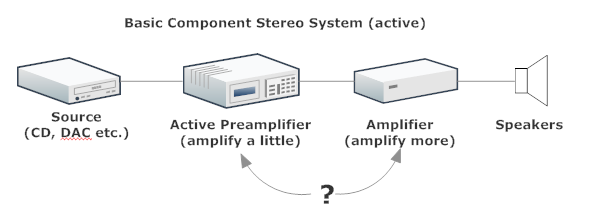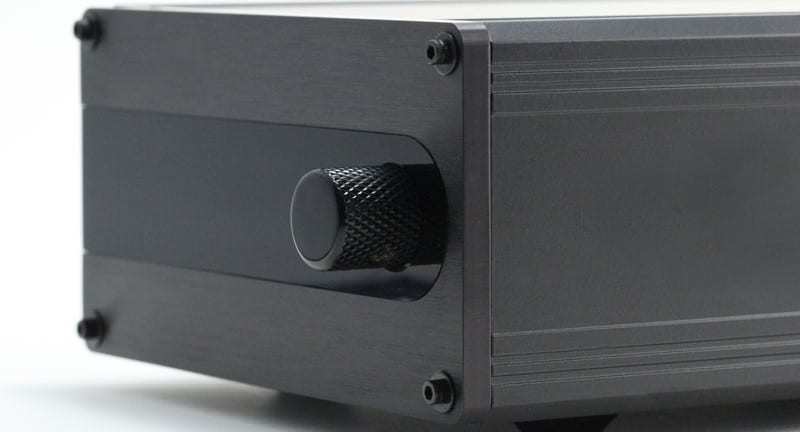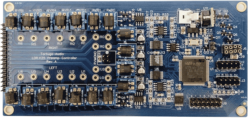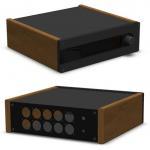What is a Preamplifier and Why Passive?
The Perfect Preamplifier – No Preamp At All

If you read enough articles on high performance audio you eventually encounter the definition of a perfect preamp: no preamp at all. Just a short wire between the source and the amplifier. Purity of audio signal unsullied by intervening gear.
The problem with no preamp (or a perfect “wire preamp”) is most music sources put out a high enough voltage signal that once it’s amplified by your amplifier it can be frighteningly loud and damaging to your speakers. All fine and good provided you live alone, have few if any neighbors nearby, and don’t give a fig about your gear or going deaf.
The reality is a preamp is an essential part of any audio reproduction system. Even integrated amps with everything in one box still have a preamp inside. Why kind of preamp? Well, that’s another matter. Let’s move on.
What Is A Preamplifier and What Does It Do?
Your source (CD, DAC, phono stage etc.) typically puts out a voltage signal in the range of 1-3 volts with ~2 volts being fairly typical these days. This is not a constant DC voltage (which should be zero by the way) but is the average (RMS – root mean squared) of the varying (AC – alternating) voltage waveform as music is played. This is referred to as a “line” or “line stage” output signal.
Preamps are placed between your source and your amp. All preamps must do one key thing and may also do three optional things:
Control Volume (Attenuate) – Preamps control volume by reducing the line voltage that reaches the amp. This reduction in voltage is referred to as “attenuation”. Hence engineers often refer to volume controllers as attenuators (probably because it sounds more serious and intelligent). All preamps attenuate. The following three functions are optional.
Switch Inputs – Most preamps have more than 1 stereo input channel and are able to switch between these inputs. Today it’s not unusual for someone to have both a DAC and a turntable. Both get plugged into the preamp and the listener uses the preamp to switch between them as desired. Switching can be via a rotary mechanical switch or via relays and may be done locally at the preamp panel or via a remote.
Isolate Input from Output (Buffer) – Your typical source doesn’t want to work too hard delivering its voltage to your amplifier. Why? The less hard it has t work the better it sounds (up to a point). Think of voltage as being equivalent to water pressure. It’s not the flow rate of the water (current) that delivers the music signal, it’s the fluctuations in the water pressure (voltage) that matters. Your source wants to deliver those pressure signals while delivering very little actual water to your amp. Preamps can act as “buffers” between your source and amplifier. Buffered preamps pass on the pressure waves in the water but not the water itself. Very clever. Yes, this is an oversimplification and yes then there’s the whole subject of impedance matching vs. bridging but let’s mush ahead.
Amplify the Input (Gain) – Amplification is the opposite of attenuation. When you amplify you increase the voltage level of the source signal. Wait! Hold on! Am I telling you that a preamp whose primary purpose is to attenuate (control volume via voltage reduction) can also amplify (increase volume via voltage increase)? Yes, I am. Confused yet? Turns out there are some amplifiers (low wattage tube amps typically) that need more than your typical line stage voltage in order to play loud enough to satisfy. So preamp to the rescue. Preamps that increase the incoming line stage voltage are said to have “gain” as in gaining voltage. Gain is the ratio of output voltage over input voltage. Unity gain (1x) means there is no amplification. A gain of 1.25x means the voltage is increased by 25%. Gain is often expressed in decibels (dB). A preamp with a gain of 2x is the same as 20xlog(2) or 6 dB. Enough math.
The Active Preamps?
Active preamps are called “active” because they do indeed act on the audio signal. At the very least they act as a buffer and in most cases active preamps also have gain. They have power supplies that touch and manipulate the audio signal. Active preamps invariably impart their own “color” on to the audio signal. Traditionally, most preamps are active preamps.
You can think of an active preamp as being a little amplifier in front of a big amplifier. So now your music gets to go through 2 complex devices full of transformers, rectifiers, capacitors, resistors, inductors, diodes, wire, yada yada yada etc.
Here we finally get to the ironic big reveal. Very few audio systems today need pre-amplification (little gain) before they are then amplified (big gain).

If you subscribe to the “less-is-more” school of audio design, the less “stuff” the audio signal has to go through on its way from source to speaker the better.
So why are most preamps active preamps? Here are a few reasons:
- I like the idea of all that those cool electronics in my signal path (really?)
- I need the extra gain (really? probably not)
- I need the buffer (maybe, but probably not)
- I like the way it colors the music (really? think about this for a while)
- It’s what the popular manufacturers are offering (true enough)
- I tried a passive preamp once and was disappointed (fair enough, but not all passives are created equal).
A Passive Preamplifier
An unapologetic oxymoron, a passive preamplifier does not amplify (or buffer); hence the adjective “passive”. Of the four things a preamp can do a typical passive preamp does at least one thing (control volume) and sometimes a second (switch inputs).

But that “one thing” that a passive preamp always does, it can do very well. In a very real way, the passive preamp comes close to being that perfect “just a short wire between the line source and the amplifier”; except with the civilized addition of volume control.
Most passive preamps are simply a potentiometer or stepped attenuator with volume control knob. The most common complaint about passive preamps is they lack the dynamic “whomp” of an active preamp.
LDR Passive Preamplifier
Tortuga Audio’s passive preamplifiers utilize an entirely different technology compared traditional passive preamps. Our preamps are designed with light dependent resistors – LDRs. No potentiometers. No stepped attenuations. No transformers.
A properly designed LDR passive preamp will far exceed the performance of traditional passive preamps and equal or surpass the performance of even the best active preamps regardless of cost.
Don’t take our word for it. We invite you to discover what you’ve been missing. Tortuga Audio offers a generous 30 day in-home buy-and-try audition policy with a full refund of the purchase price if you’re not satisfied.
Curious? Find out more about our LDR passive preamp products.






